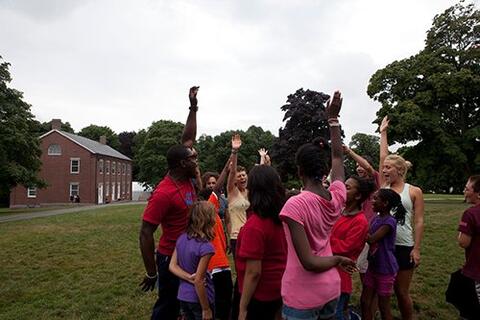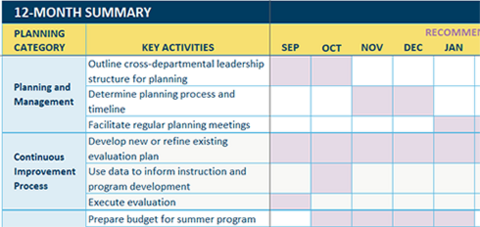Breadcrumb
- Wallace
- Toolkits
- Summer Learning Toolkit
Summer Learning Toolkit

Site Climate
Site climate refers to the quality and character of the program, relationships, and teaching and learning practices that shape youth and staff experiences. It’s the foundation for the shared norms, goals and values that define the program culture and environment. RAND found that sites with an inclusive friendly climate and engaged staff promote both positive youth experiences and regular attendance. Students benefit from programs marked by clarity of purpose, consistency, warmth and engagement. Positive site climates rarely develop on their own and instead require deliberate effort. Rather, program leaders should define goals for a positive site climate early in the planning process so it can inform key elements of staff planning, training and site logistics (see more in Staffing and Professional Development).

Examples Milestones for Site Climate

Creating a warm and welcoming environment
A warm and welcoming environment helps students feel safe, appreciated and bonded with staff and peers. In a positive site climate, students and staff know what to expect and what is expected of them.

- Be consistent with behavior: Develop and apply appropriate student behavior policies that are aligned with the climate you want to create at your site. Check out Rochester’s approach in their staff handbook.
- Break the ice: Include “getting-to-know-you” activities in both staff training and the program’s first week.
- Have fun: Plan daily and weekly rituals that lift up student voices in songs, chants and recognition. Showcase student work and program themes in décor. Pittsburgh’s site leadership handbook provides good examples.
Related Resources
Tip Sheet - Promoting Student Participation and Positive Experiences
Best practices for attendance, family outreach and site climate
Sample - Pittsburgh Positive Site Climate Strategies
Describes core elements of program culture and tips for implementation
Equipping staff to implement the mission
Your program’s staff are important “culture keepers” and will benefit from clear guidance and opportunities to contribute to the site’s climate. Equip them with the resources and learning opportunities they need to be successful.
- Put it in writing: Develop a staff manual with the program’s mission, vision, policies and leadership structure.
- Assign clear staff roles: Identify who monitors meals, leads classes and helps transition students to and from classes.
- Provide ample time for training and planning: Develop a training schedule and agenda that include time for both program orientation and site-team collaborative planning (see more in Staffing and Professional Development).

Related Resources
Sample – Pittsburgh Site Leadership Handbook
Describes staff roles and includes staff training agendas
Sample - Rochester Summer Staff Handbook
Includes a behavior- management strategy with related classroom rubrics and techniques
Planning for logistics that impact site climate
While staffing and policies are important elements of a site’s climate, many other factors influence the experience for students and staff. These include the quality of the program’s physical space, meals, transportation and supplies.
- Select sites thoughtfully: Keep in mind the anticipated number of students, special facility or equipment needs, planned capital improvements and school feeder patterns.
- Keep it together: Confirm that meal and snack times do not break up instructional blocks.
- Be an early bird: Test your bus routes prior to the program’s first day. Ensure supplies are delivered at least one week prior to the start of the program.
Related Resources
Tool - Summer Planning Calendar
Comprehensive to-do list by month and topic paired with expert guidance
GET THE LATEST UPDATES

